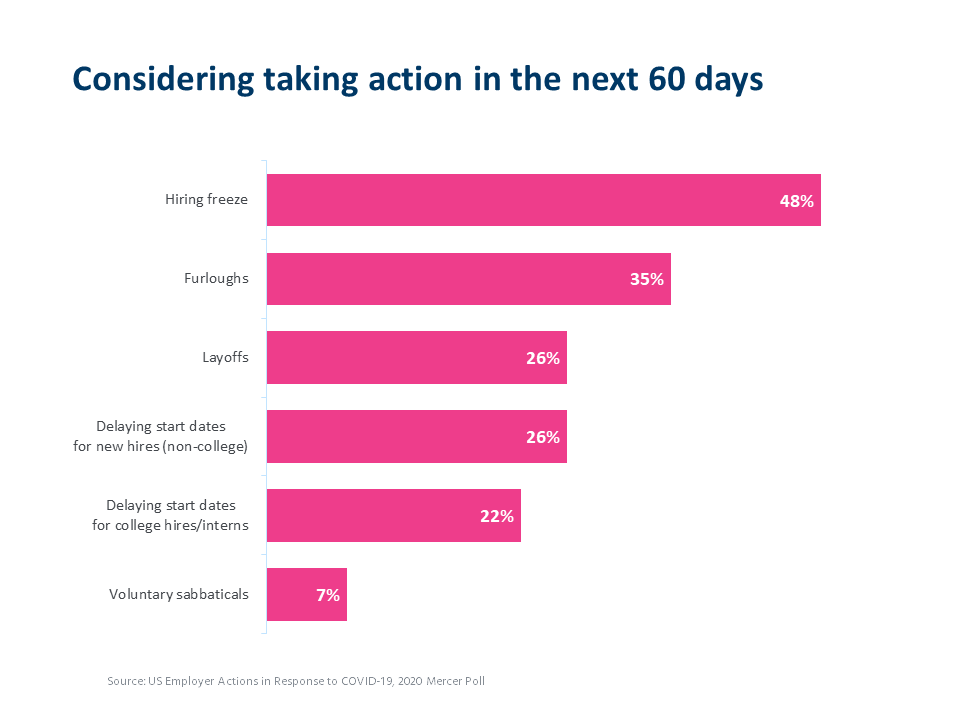Poll Results: Furloughs, Lay-offs, and Health Benefit Decisions
 FRANCESCO CARTA
FRANCESCO CARTA
Employers seeking to manage cost in the challenging business environment created by the COVID-19 pandemic have had to consider workforce alternatives that may influence the nature of work, the location of work, or the number of employees at an organization. A few have begun to explore novel solutions, like sharing workers with organizations that need extra hands, as described in this post
But when furloughs or layoffs seem inevitable, employers are striving to find ways to fuse economics and empathy in their choices about handling pay and benefits under various scenarios. As hard as these workforce actions can be, employers who get it right can maintain – or even improve – employee engagement and experience over the long term.
When an employer furloughs its employees, it requires them to work fewer hours or to take a certain amount of unpaid time off. An employer may require all employees to go on furlough, or it may exclude some employees who provide essential services. Generally, the theory is to have the majority of employees share some hardship as opposed to a few employees losing their jobs completely.
A layoff is a temporary separation from payroll. An employee is laid off because there is not enough workfor him or her to perform. The employer, however, believes that this condition will change and intends to recall the person when work again becomes available. Employees are typically able to collect unemployment benefits, and employers may allow employees to maintain benefit coverage for a defined period of time as an incentive to return to work. Or, if the employee loses coverage, employers may elect to subsidize their COBRA payments for a period of time.

In a Mercer poll that opened on April 2, just over a third (35%) of the more than 400 employers that responded through April 9 said they are considering furloughs within the next 60 days, while just over a fourth are considering lay-offs. Under both scenarios, employers must decide whether to continue or terminate health and welfare benefits. While decisions must be validated by legal counsel, we can offer some important considerations:
If benefits will continue:
- Do plan eligibility/contract provisions allow or require continuation (do they need to be amended)? Note that this applies to all types of coverages, including voluntary benefits.
- Can the employee switch to a lower cost option, drop and enroll on a spouse’s plan, public exchange coverage or Medicaid?
- Will the employer cover the full employee contribution? If so, for how long?
- If the employer will not pay the contributions, how will employee contributions be collected?
If benefits will be terminated:
- Is there a legal requirement to offer continuation of coverage (e.g. COBRA, conversion, portability)?
- Will the employer pay COBRA subsidies? If so, for how long?
- If benefits are terminated, how will they be reinstated upon return?
In the Mercer poll, 55% of the employers considering furloughs say they would continue health benefits while just 3% said they would not; the rest were still undecided. Those continuing coverage were fairly evenly split between waiving employee contributions (23%) and continuing them (29%), either by collecting contributions in installments (14%) or requiring “catch-up” contributions once employees return to work (15%); the rest were undecided.
The poll asked employers considering layoffs whether they would subsidize COBRA if health benefits were terminated. While half remain undecided, only 15% said they would be likely to partially or fully subsidize COBRA payments, while 33% said they would not.
Seeking the best possible outcome for employees
While furloughs and lay-offs inherently have a negative impact on employee engagement in the short-term, employers have many choices to make that can mitigate the long-term impact. Because health benefits are very important to employees in the best of times, and even more so during a health crisis, as you work through the possibilities for handling benefits in a workforce action, test each one against the question, “is this the best possible outcome for our employees under the circumstances?” An integral part of this process will be the communication plan: determining how you will communicate with both workers who are furloughed and workers who continue to work, as well as with the marketplace and your customers.
Mercer’s poll, US Employer Actions in Response to COVID-19, is still open. Please take the brief survey; you will be redirected to the live results as soon as you submit your responses. All individual responses are kept strictly confidential.
